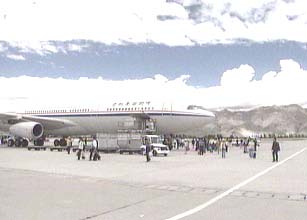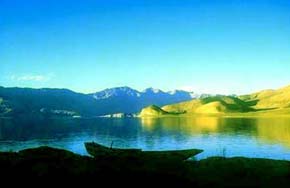John's journey into Tibet was much smoother than trips made by earlier explorers, who documented their adventures on horseback a hundred years ago.
 At that time, people from the outside world opened up roads along the rugged mountain path into Tibet. When the British Indian troops invaded Tibet in the early 20th century, cannons had to be disassembled and transported section by section, carried by horses and mules. Despite the unpredictable difficulties lying ahead, many people still dreamed of unveiling the mystery of Tibet: the shining Potala Palace, the praying of Tibetan Buddhist Lamas, and the sounds of nature thriving on the plateau. Nowadays, it takes only a few hours on a comfortable airline to arrive at the Roof of the World and to see all these things. No wonder modern tourists are fascinated.
At that time, people from the outside world opened up roads along the rugged mountain path into Tibet. When the British Indian troops invaded Tibet in the early 20th century, cannons had to be disassembled and transported section by section, carried by horses and mules. Despite the unpredictable difficulties lying ahead, many people still dreamed of unveiling the mystery of Tibet: the shining Potala Palace, the praying of Tibetan Buddhist Lamas, and the sounds of nature thriving on the plateau. Nowadays, it takes only a few hours on a comfortable airline to arrive at the Roof of the World and to see all these things. No wonder modern tourists are fascinated.
In the era of the Dalai Lama's administration, Tibet was seldom visited by foreigners. Chains of mountains formed a natural barrier between the outside world and the almost isolated Tibetan society. Tibetans lived in the remote land practicing their religion. The road system was so underdeveloped that vehicles would have found it impossible to travel them. Wheels that roll forward played no part in the traditional Tibetan lifestyle of the past.
It is said that the road at the back of the Potala Palace was the first one ever used for modern transportation. Before that, the Dalai Lama used a sedan chair to get around, and rode a horse for long distance traveling, It wasn't terribly inconvenient for the Dalai Lama, so the government didn't pay much attention to road construction either.
 In 1951, the central government of the People's Republic of China and the local Tibetan government negotiated for the peaceful liberation of Tibet. According to a mutual agreement the two parties reached at the negotiating table, the central government would send the People's Liberation Army into Tibet to help the government to carry out reforms. Soon the PLA marched toward Tibet from three directions. As a direct result, two roads that can accommodate trucks were built leading into Tibet. As the army marched toward Tibet, road construction troops followed and completed the construction.
In 1951, the central government of the People's Republic of China and the local Tibetan government negotiated for the peaceful liberation of Tibet. According to a mutual agreement the two parties reached at the negotiating table, the central government would send the People's Liberation Army into Tibet to help the government to carry out reforms. Soon the PLA marched toward Tibet from three directions. As a direct result, two roads that can accommodate trucks were built leading into Tibet. As the army marched toward Tibet, road construction troops followed and completed the construction.
By the Lhasa River, where the Sichuan-Tibet Highway and Qinghai-Tibet Highway meet, stands a monument dedicated to the soldiers who devoted their lives to the construction of the roads into Tibet, and to the people who have sacrificed for it. These two roads run through the mountain ranges and brought major changes to Tibet. Soldiers who participated in the highway construction still recall the scenes of the construction site.
After years of hard work, the two highways, measuring eight thousand kilometers each, finally reached Lhasa. Tibet's isolation was now a thing of the past. Tibet went forward on wheels from then on. Local people take the highways and automobiles for granted nowadays, but Tibetans at that time were surprised by all the attention.

Changes in transportation also brought changes in the social structure. Tibetan residents who never knew anything about machinery began to learn to drive.
The geological structure of Tibet is still fragile, demanding a large road maintenance crew. Tibetan farmers became organized with the coming of the railroad and highways and the new work improved their living standards.
New ideas are emerging rapidly. People now use electricity, no longer the butter oil that was used to light the Buddha. Simple industries emerged from small-scale machinery processing plants, originally built for vehicle maintenance and infrastructure construction.
The old days have already faded away. Memories of the past are recorded only in the minds of the elderly or on film. Children today have no idea that transportation in the past was mainly reliant on the serfs, who took turns to labor for the temples or the government.
Children today don't understand just how hard life used to be. They take many things for granted. Today, there is an even more prosperous outlook for Tibet in the new century. Commerce and tourism have made much headway, in addition to the new abundant harvests in agriculture and animal husbandry, which are the foundation of economic growth in Tibet.
In most cities and towns in Tibet, people don't feel that they are separate from the outside world. A wide range of food, drinks and all kinds of entertainment are popular not only with ordinary Tibetans, but with holy monks as well. The abundance in Tibet makes it possible to receive more visitors, tourism-related industries are expanding as a result. Taxi drivers are even able to serve visitors in several languages.
In order to strengthen communication between Tibet and the outside world, the Central Government resolved to construct a 2,000 kilometer-long railway on the Qinghai-Tibet Plateau in 2000.
The children have only seen trains on television, and now they will see it for real. What will the train bring to them then?
|